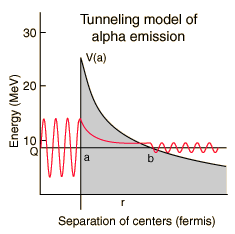For infinity potential well we take the analogy with nucleus. Inside which proton and neutron are bound in principle, if it is an infinite potential well, so particle should not come outside the nucleus. But what happens at the time of nuclear decay or radioactivity at that time particle come outside either through alpha or beta or Gama decay. How this could we possible??
-
2$\begingroup$ Why do you think that a nucleus is anything like an infinite potential well? Look at the potential energy curve between nucleons. It becomes horizontal, not vertical! $\endgroup$– GhosterCommented Oct 25, 2022 at 4:00
-
$\begingroup$ So what is the example of infinity potential well. $\endgroup$– QUANTUM WORLDCommented Oct 25, 2022 at 4:18
-
2$\begingroup$ The usual example given is a ‘particle in a box” when the walls are impenetrable, but there is no real physical system like this. It’s an idealization which happens to be very easy to solve and thus makes for a good first problem in an introductory QM course. $\endgroup$– GhosterCommented Oct 25, 2022 at 4:25
-
$\begingroup$ And to complete the line of reasoning in the @Ghoster comments... write down the Schroedinger equation with a finite potential well and include unbound solutions into your Ansatz. Calculate the time dependent solutions and you will see "decay" reproduced by the equation "easily". $\endgroup$– FlatterMannCommented Oct 25, 2022 at 8:59
2 Answers
In the real world there is no "infinity". The nucleus is not an infinite potential well, you can extract stuff from the nucleus if you put in a large-but-still-finite amount of energy. This explains why alpha radiation can happen.
You could say the infinite square well is a "particle in a box", but that's still an idealized system because no real-world box has infinitely high walls.
Of course, the real reason why we study the infinite square well in elementary quantum mechanics courses is because it's easy to solve - it's the easiest exactly solvable system - and still illustrates all the quantum weirdness that one will encounter later in QM.
Neutrons and protons in a nucleus are bound via strong interactions (and to some extent also through weak interactions) with the binding energies much greater than the Coulomb interaction between the protons and electrons (or protons and protons in the nucleus itself.)
This is the reason why in the textbooks non-relativistic quantum mechanics one can
- consider the nucleus as a single charged particle when calculating atomic energy levels
- consider the nucleus as an infinite potential well as a rough approximation for the intra-nuclear exitations (see, e.g., "Fundamentals in nuclear physics" by Besdevant, Rich and Spiro.)
However, as the OP correctly points out, description of nuclear decay requires more complex models. The simplest description of alpha decay is the Gamow model with a potential that looks like this (taken from this page) - note how it resembles a square quantum well close to the center.

Note that alpha decay, beta decay and gamma decay are three very different types of processes. Thus, in gamma decay only electromagnetic radiation is emitted by the nucleus, so the infinite height of the barrier is not the problem - what is missing in the model of infinite quantum well is coupling to the electromagnetic field. (See this thread for more on gamma decay.)
